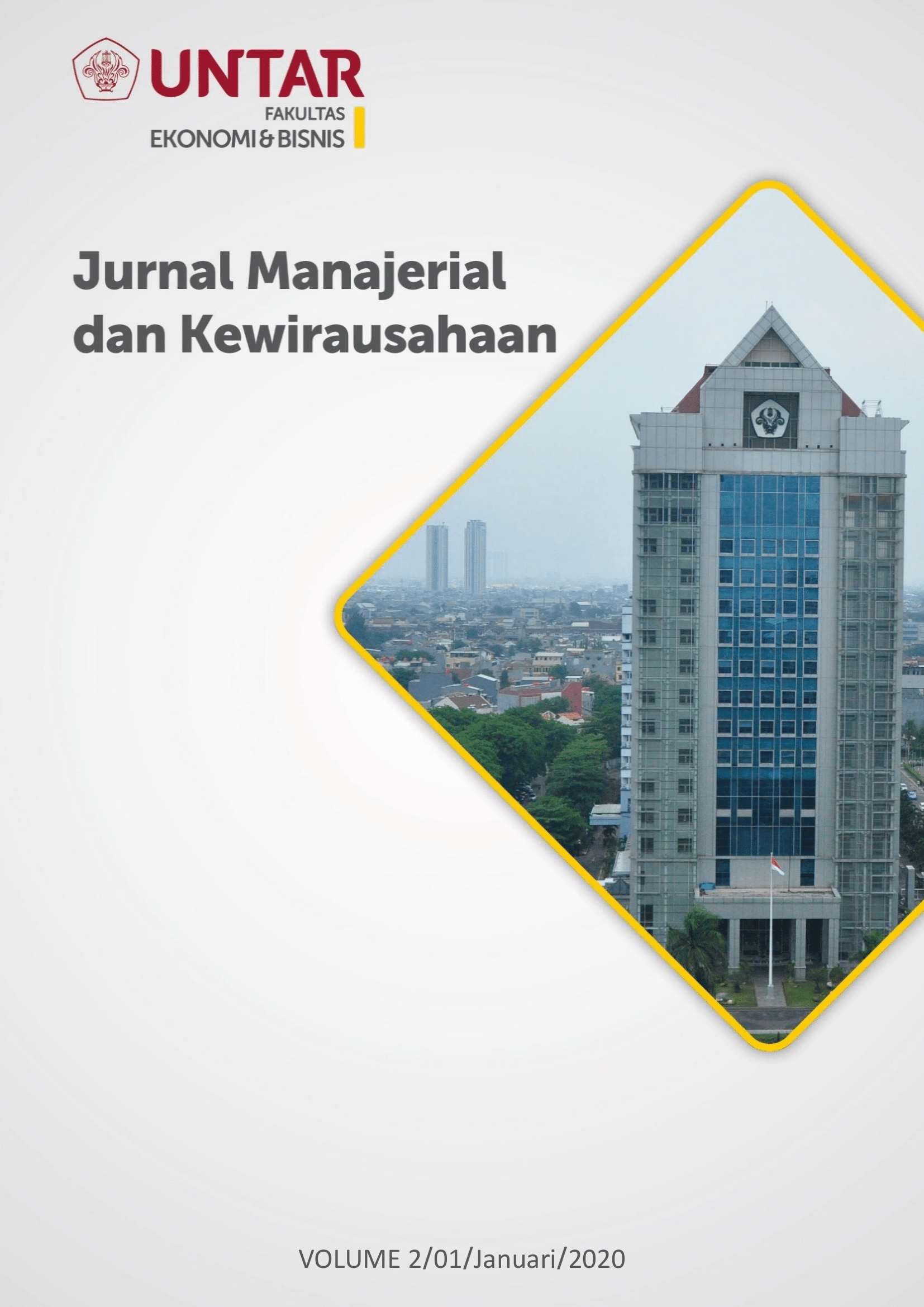Pengaruh Inovasi, Kepercayaan Diri Dan Pengambilan Risiko Terhadap Intensi Berwirausaha Pada Mahasiswa Universitas Tarumanagara
Main Article Content
Abstract
The purpose of this study was to determine the effect of innovation, self-confidence, and risk taking on entrepreneurial intentions. The sample was chosen using nonprobability sampling technique with a number of 100 respondents from Tarumangara University students. The questionnaire was distributed using Google Form and analyzed using the SmartPLS 3.0 program. Individually and as a whole, the results of this study indicate that innovation, self-confidence, and risk taking have a positive effect on entrepreneurial intentions. This means that in entrepreneurial intentions are needed which is innovation, confidence, and risk taking.
Tujuan penelitian ini adalah untuk mengetahui pengaruh inovasi, kepercayaan diri, dan pengambilan risiko terhadap intensi berwirausaha. Sampel dipilih menggunakan teknik nonprobability sampling dengan jumlah 100 responden mahasiswa Universitas Tarumangara. Kuesioner disebar menggunakan google form dan dianalisis dengan menggunakan program SmartPLS 3.0. Secara individu dan keseluruhan, hasil penelitian ini menunjukkan bahwa inovasi, kepercayaan diri, dan pengambilan risiko berpengaruh positif terhadap intensi berwirausaha. Artinya dalam intensi berwirausaha dibutuhkan antara lain inovasi, kepercayaan diri, dan pengambilan risiko.
Article Details
This work is licensed under a Jurnal Muara Ilmu Ekonomi dan Bisnis Creative Commons Attribution-ShareAlike 4.0 International License.,/p>
References
Ajzen, I. (1991). The theory of planned behavior. Organizational Behavior and Human Decision Process, 50, 179–211.
Baron, R. A., & Byrne, D. (2003). Psikologi sosial. Jakarta: Erlangga.
Caliendo, M., Fossen F. M. and Kritikos A. S. (2009). Risk Attitudes of Nascent Entrepreneurs-New Evidence from an Experimentally-Validated Survey. Small Business Economics, Vol. 32, No. 2, pp.153-167.
Chen, M. H. (2007). Entrepreneurial leadership and new ventures: creativity on entrepreneurial teams. Creativity and Innovation Management, 16(3), 239–249.
Cohen, Jacob. (1988). Statistical Power Analysist for the Behavioral Sciences (Ed. 2). Hillsdale: Erlbaum Associates.
Diaz-Garcia, M., and J. Jimenez-Moreno. 2010. Entrepreneurial Intentions: The Role of Gender. International Entrepreneurship and Management Journal, 4(4), 467–83.
Espíritu-Olmos, R., & Sastre-Castillo, M. (2015). Personality traits versus work values: comparing psychological theories on entrepreneurial intention. Journal Of Business Research, 68(7), 1595-1598.
Fayolle, A., Gailly, B. and Lassas-Clerc, N. (2006). Assessing the impact of entrepreneurship education programmes: a new methodology. Journal of European Industrial Training, Vol. 30, No. 9, pp. 701-720.
Ferreira, J. J., Raposo, M. L., Rodrigues, R. G., Dinis, A. and Paço, A. D. (2012). A model of entrepreneurial intention: an application of the psychological and behavioral approaches. Journal of Small Business and Enterprise Development, Vol. 19, No. 3, pp. 424-440.
Fontana, Avanti. (2016). Innovation or Die: What A Company Was Do. Materi dipresentasikan pada Indonesia Knowledge Forum V-2016 7 Oktober 2016.
Garaika, & Margahana, H. (2019). Self Efficacy, Self Personality and Self Confidence on Entrepreneurial Intention: Study on Young Enterprises. Journal of Entrepreneurship Education, 2(1).
Gelaidan, H. M., Abdullateef, A. O. (2017). Entrepreneurial intentions of business students in Malaysia: The role of self-confidence, educational and relation support. Journal of Small Business and Enterprise Development, 24(1), 54-67.
Ghozali, I. (2014). Structural Equation Modeling, Metode Alternatif dengan Partial Least Square (PLS). Edisi 4. Semarang: Badan Penerbit Universitas.
Gurel, E., Altinay, L. and Daniele, R. (2010). Tourism students’ entrepreneurial intentions. Annals of Tourism Research, Vol. 37, No. 3, pp. 646-669.
Hair, J. F., Ringle, C. M., & Sarstedt, M. (2011). PLS-SEM: Indeed a Silver Bullet. The Journal of Marketing Theory and Practice, 19(2), 139-151.
Ho, T. S. and Koh, H. C. (1992). Differences in psychological characteristics between entrepreneurially inclined and non-entrepreneurially inclined accounting graduates in Singapore. Entrepreneurship, Innovation and Change: An International Journal, Vol. 1, No. 2, pp. 243-254.
Kusmintarti, A., Asdani, A., & Riwajanti, N. I. (2017). The relationship between creativity, entrepreneurial attitude and entrepreneurial intention (case study on the students of State Polytechnic Malang). Int. J. Trade and Global Markets, 10(1), 28–36.
Lee, L., Wong, P. K., Chua, B. L. and Chen, J. (2011). Antecedents for entrepreneurial propensity: Findings from Singapore, Hong Kong and Taiwan.
Luthje, C. & Franke, N. (2003). The making of an entrepreneur: testing a model of entrepreneurial intent among engineering students at MIT. R&D Management, 33(2), 135-47.
Malhotra, N. K. (2015). Essentials of Marketing Research. England: Pearson Education Limited.
Rauch, A., & Frese, M. (2007). Let’s put the person back into entrepreneurship research: A meta-analysis between business owners’ personality traits, business creation, and success. European Journal of Work and Organizational Psychology, 16(4), 353-385.
Sekaran, U., & Bougie, R. (2013). Research Methods for Business (6th ed.). Italy: Printer Trento Srl.
Suryana. (2011). Kewirausahaan Pendoman Praktis: Kiat dan Proses Menuju Sukses. Jakarta: Salemba Empat.
Tubbs, M. E., & Ekeberg, S. E. (1991). The role of intentions in work motivation: Implications for goal-setting theory and research. The Academy of Management Review, 16(1), 180-199.
Turker, D., & Selcuk, S. S. (2009). Which factors affect entrepreneurial intention of university students? Journal of European Industrial Training, 33(2), 142–159.
Vidal-Sune, A. and Lopez-Panisello, M. (2013). Institutional and economic determinants of the perception of opportunities and entrepreneurial intention. Investigaciones Regionales, Vol. 26, pp. 75-96.
Wang, C. K., & Wong, P.-K. (2004). Entrepreneurial interest of university students in Singapore. Technovation, 24(2), 163–172.
Wetzels, M., Odekerken-Schroder, G., & Van Oppen, C. (2009). Using PLS path modeling for assessing hierarchical construct models: Guidelines and empirical illustration. MIS Quarterly, 33(1), 177-195.



